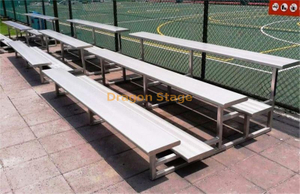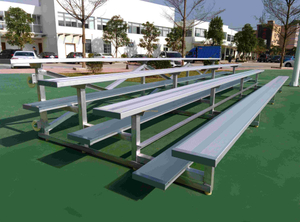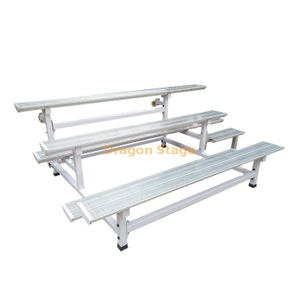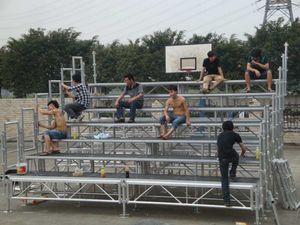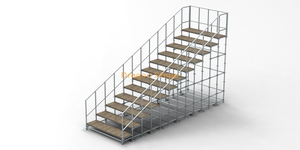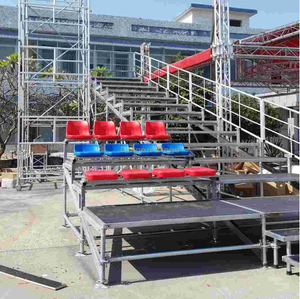| first layer height 0.5m and each layher depth 2m | SPEC | QTY |
| 0.25m pillar | 50*4MM | 40 |
| 0.5m pillar | 50*4MM | 40 |
| 1m pillar | 50*4MM | 80 |
| 1*2m deck+quick lock+ 2 corners | 1*2m | 63 |
| 1*2m deck+quick lock | 1*2m | 63 |
| aluminum beam 2m | ∕ | 70 |
| 0.7m steel adjustable base | 0.7m | 80 |
| horizental bar 2m | 50*3 | 180 |
| brace bar | 50*3 | 57 |
Platform Specifications:
First layer height: 0.5m
Layer depth: 2m
Maximum height: 2m
Length: 18m
Depth: 14m
Number of layers: 7
Number of lines: 9
Audience capacity: 252
Analysis:
The proposed platform presents several unique challenges due to its significant dimensions and the absence of supporting structures like stairs or handrails. A thorough analysis is necessary to determine the feasibility of such a design and address potential safety concerns.
Structural Considerations:
Load Capacity: The primary concern is the platform's ability to support the weight of 252 individuals, along with any additional structural elements and potential dynamic loads. The weight of each individual should be factored in, along with the potential for uneven weight distribution. A structural engineer will need to analyze the load capacity of the chosen materials and design the platform's structural elements accordingly.
Material Selection: The platform's material choice will significantly impact its stability and load capacity. Steel or reinforced concrete are generally preferred for large-scale platforms due to their strength and durability. However, other materials, such as engineered wood products, may also be considered depending on the specific requirements.
Support System: The lack of stairs and handrails necessitates a self-supporting structure. This can be achieved through a combination of strong beams and columns strategically placed to distribute the load evenly. The design must ensure the platform remains stable under the combined load of the audience, wind pressure, and any potential seismic activity.
Stability Analysis: A thorough stability analysis must be conducted to ensure the platform remains structurally sound under various load scenarios. This analysis should consider the platform's weight, the weight of the audience, wind forces, and any potential seismic loads.
Safety Concerns:
Access and Egress: The absence of stairs raises serious safety concerns. Alternative access methods, such as ramps or ladders, will need to be implemented to ensure safe ingress and egress for the audience.
Fall Hazards: The lack of handrails poses a significant fall hazard, particularly for individuals navigating the platform's perimeter. Safeguarding measures, such as strategically placed barriers or a combination of physical and visual cues, will be crucial.
Crowd Management: A platform with a large audience capacity presents significant crowd management challenges. Clear and well-defined pathways for movement and egress will be essential to prevent overcrowding and potential accidents.
Emergency Response: The absence of typical platform features necessitates a comprehensive emergency response plan. This should include clearly marked emergency exits, adequate lighting, and a communication system for alerting authorities in case of an emergency.
Recommended Actions:
Detailed Structural Analysis: Conduct a thorough structural analysis by a qualified engineer to determine the optimal design for the platform, considering the specific load conditions and environmental factors.
Material Selection: Based on the structural analysis, select appropriate materials for the platform construction. Consider the load capacity, durability, and environmental impact of each material.
Safety Measures: Implement comprehensive safety measures to mitigate fall hazards, ensure crowd control, and facilitate emergency response. This may include installing temporary barriers, clearly marked pathways, emergency exits, and a communication system.
Risk Assessment: Conduct a detailed risk assessment to identify potential hazards and develop mitigation strategies. This will help ensure the safety of the audience and comply with relevant regulations.
Conclusion:
Constructing a large-scale, un-supported platform requires careful consideration of structural integrity, safety concerns, and regulatory compliance. A comprehensive design process, incorporating detailed structural analysis, appropriate material selection, and robust safety measures, is crucial to ensure a safe and successful project. Close collaboration between designers, engineers, and relevant authorities will be essential for addressing the unique challenges presented by this unconventional platform design.

















